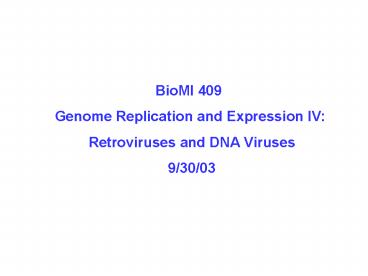Hepadnavirus DNA Genome PowerPoint PPT Presentation
1 / 22
Title: Hepadnavirus DNA Genome
1
BioMI 409 Genome Replication and Expression IV
Retroviruses and DNA Viruses 9/30/03
2
Hepadnaviruses and Caulimoviruses DNA Genomes
Reverse Transcribed from a RNA Template
From Flint et al. Principles of Virology (2000),
ASM Press
3
Hepadnavirus Replication
From Flint et al. Principles of Virology (2000),
ASM Press
4
Hepadnavirus Caulimovirus vs. Retrovirus RT
Replication
5
DNA VIRUSES
- ADVANTAGES
- Genome is same structure as host cell chromosomes
- replication resembles that of host
- use host enzymes
- Control elements that regulate genes expression
are the same as those found in host cell
genes - use host enzymes for transcription/processing
mRNAS - Eukaryotic DNA viruses replicate in the
nucleus - exception vaccinia, pararetroid (e.g. CaMV)
- PROBLEM
- Requires a primer to initiate DNA replication
- same problem faced by the host cell DNA
polymerases do not initiate synthesis on ssDNA
templates, they only extend from double-stranded
regions (5 ? 3) - how faithfully replicate ends without losing
information? - solution specialized structural features of
genomes
6
Modes of DNA Virus Replication The Primer Problem
7
Host Cell Nuclear Functions that DNA Viruses Need
- Transcriptional activators and co-activators
- initiate gene transcription
- RNA polymerase II complexes
- transcribes mRNAs
- Enzymes for processing and capping mRNA
transcripts - DNA polymerases and associated proteins
- includes gyrase, ATPase, helicase activities
- Primase (RNA primer), RNase, gap repair enzymes,
ligase
8
Multiplication cycle of eukaryotic DNA viruses
replication of viral DNA, and transcription and
processing of late mRNAs
Appendix SV40, Adeno, Herpes
9
DNA Viruses Temporally Regulate their Gene
Expression
- Early genes expressed prior to the onset of
viral DNA replication
- Late genes expressed following the onset of
viral DNA replication
Early and Late genes are usually clustered, which
facilitates their coordinate regulation
10
DNA Virus Transcriptional Cascade
Initiate vDNA synthesis
Activate viral gene expression
11
SV40 and Polyoma
Important models for eukaryotic DNA replication
and gene regulation
First eukaryotic transcription factor (SP1)
First eukaryotic transcriptional enhancer
Genetic dissection of eukaryotic promoter
Initiation of eukaryotic DNA replication
First nuclear localization signal (NLS) T
antigen
12
SV40 Genome Circular dsDNA
Temporal Expression Cascade
Late Structural proteins (VP1, VP2, VP3)
- ORI unique
- Termination 180o from ori - opposite side of
- circle where replication forks meet
From Flint et al. Principles of Virology (2000),
ASM Press
13
SV40 Transcription
E L proteins encoded on opposite DNA strands
From Flint et al. Principles of Virology (2000),
ASM Press
14
SV40 Physical and Genetic Maps are Co-linear
(Based on Lai Nathans (1975) Virology 6670)
tsA, tsB, tsC temperature sensitive mutants
that genetically complement each other
15
Mapping the Replication Origin of SV40
isolate completely replicated SV40 genomes
16
Mapping the Replication Origin of SV40
(based on Danna Nathans (1972) PNAS 692391)
17
SV40 Ori
From Flint et al. Principles of Virology (2000),
ASM Press
18
SV40 T is a Multifunctional Protein with Discrete
Functional Domains
- Represses own transcription (negative feedback).
Opens up L promoter, - making it accessible to RNA pol II and
activating late gene expression
- Helicase Ori unwinding and movement of
replication fork. ATPase (energy)
- Binds host pRB and p53 to induces cells to enter
S phase and inhibit apoptosis
From Flint et al. Principles of Virology (2000),
ASM Press
19
DNA Virus Ori Recognition Proteins Share Common
Properties
All DNA viruses will encode at least one DNA
replication initiation protein
Larger viruses will also encode DNA polymerases
and other essential replication proteins
From Flint et al. Principles of Virology (2000),
ASM Press
20
Unwinding of the SV40 Ori
Two T hexamers bind pentanucleotide sites (II)
Flanking AT-rich element and early palindrome
(EP) protected, EP distorted
Host RpA (ssDNA binding protein) and T (helicase)
bidirectionally unwind DNA
From Flint et al. Principles of Virology (2000),
ASM Press
21
SV40 Strand Synthesis
DNA Pol a-primase binds RpA and T at Ori
RNA primers made, leading strand synthesis starts
RfC bind 3-OH of nascent RNA
Continuous, highly processive leading strand
synthesis
Lagging strand synthesis (3) initiates after
replication complex forms on leading strand
Topo I II remove supercoils to allow movement
of replication fork, Topo II breaks/seals to
separate strands
Rpreplication protein, Rfreplication factor
From Flint et al. Principles of Virology (2000),
ASM Press
22
Further Reading
1. Handout/WEB 2 graphics on UV mapping a RNA
genome
2. Reading for Retroviruses Flint et al. (2000)
Chapter 7
- Focus on Retro mechanisms of replication and
integration
3. Reading for DNA virus replication
- DiMaio Coen (2001) Chapter 6 in Fundamental
Virology (good - overview)
- Flint et al. Chapter 9 pp 287-315
Focus on SV40, Adenovirus, Herpes Simplex Virus
Skip over Epstein-Barr virus and parvoviruses
(apologies to Colin! Just glance at parvoviruses
creating structure at ends)
Do not get hung up on structural models of
proteins!

